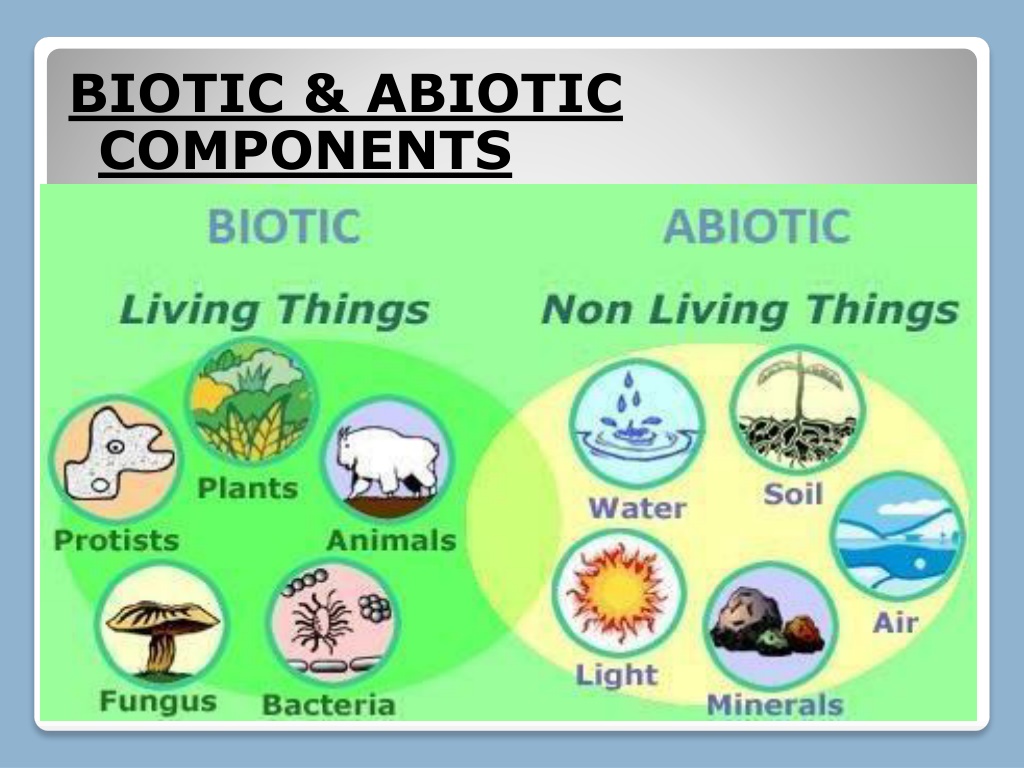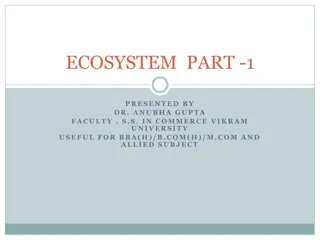Understanding Biotic and Abiotic Components in Ecosystems
Explore the relationship between biotic (living) and abiotic (non-living) components in ecosystems. Learn about the roles of plants, animals, decomposers, and scavengers. Discover the importance of biodegradable and non-biodegradable materials in the environment.
Uploaded on Sep 29, 2024 | 0 Views
Download Presentation

Please find below an Image/Link to download the presentation.
The content on the website is provided AS IS for your information and personal use only. It may not be sold, licensed, or shared on other websites without obtaining consent from the author. Download presentation by click this link. If you encounter any issues during the download, it is possible that the publisher has removed the file from their server.
E N D
Presentation Transcript
BIOTIC & ABIOTIC COMPONENTS
DEFINATIONS Plants and animals including human beings ,form the living component which are known as biotic component. Air ,water,soil,light,temperature,etc. are non-living which are known as abiotic component.
ABIOTIC COMPONENTS
DEFINATIONS HETEROTROPHS Animals cannot prepare their own food , so they depend on plants for their food. They are called consumers or heterotrophs. AUTOTROPHS The green plants which prepare their own food are called producers or autotrophs.
DECOMPOSERS & SCAVENGERS The organism which derive their food from dead and decaying plants and animals are called decomposers. Eg.Bacteria & Fungi. Animals and birds, jackal, crows etc. consume dead bodies of animals to keep the environment clean. They are called scavengers.
BIODEGRADABLE MATERIALS The materials which can be broken down into simpler substances by micro- organism are called biodegradable materials. Eg. Paper , cloth etc. NON- BIODEGRADABLE MATERIALS The materials which cannot be broken down into simpler substances are called non-biodegradable materials. Eg. Polythene,plastic etc.
THE MINERAL CYCLE The cycling of the materials through biotic and abiotic components is called mineral cycle.
OBJECTIVE TYPE QUESTIONS 1. What are the two components of our environment ? Ans. Biotic Component and Abiotic Component. 2. Define Biotic Component. Ans. Plants and animals including human beings form the living components i.e; Biotic Components. 3. Define Abiotic Component. Ans. Air , water, soil , light, temperature etc. form the non-living components i.e;Abiotic Component. 4. Name the process of preparing food by the plants. Ans. The process of preparing food by the plants is called Photosynthesis. 5. Write the equation of Photosynthesis. Ans. Carbondioxide + Water 6. Define Producers or Autotrophs. Ans. The green plants which prepare their own food are called producers or autotrophs. 7. Define Consumers or Heterotrophs. Ans. Animals that cannot prepare their own food and are dependent on producers are called Consumers or Heterotrophs. 8. Define decomposers. Ans. The organism which derive their food from dead and decaying plants and animals are called decomposers. sunlight /chlorophyll Glucose + Oxygen (Carbohydrate)
9. Define Micro-Organism. Ans. The organism like fungi and bacteria that help in decomposition and are not seen with the naked eyes are called micro-organism. 10. Define Scavengers. Ans. Animals and birds, like jackals,crow ,vulture etc. that consume the dead bodies of animals and keeps the environment clean are called scavengers. 11. Define Biodegradable materials. Ans. The materials like paper and cloth which can be broken down into simpler substances by micro-organisms are called biodegradable materials. 12. Define Non-Biodegradable materials. Ans. The materials like plastic,polythene etc. which cannot be broken down by micro- organism are called Non-biodegradable materials. 13. Name the scientific name of Morning Glory. Ans. The scientific name of Morning Glory is Ipomoea. 14. Define Mineral Cycle. Ans. The cycling of materials between biotic and abiotic components is called the mineral cycle.























